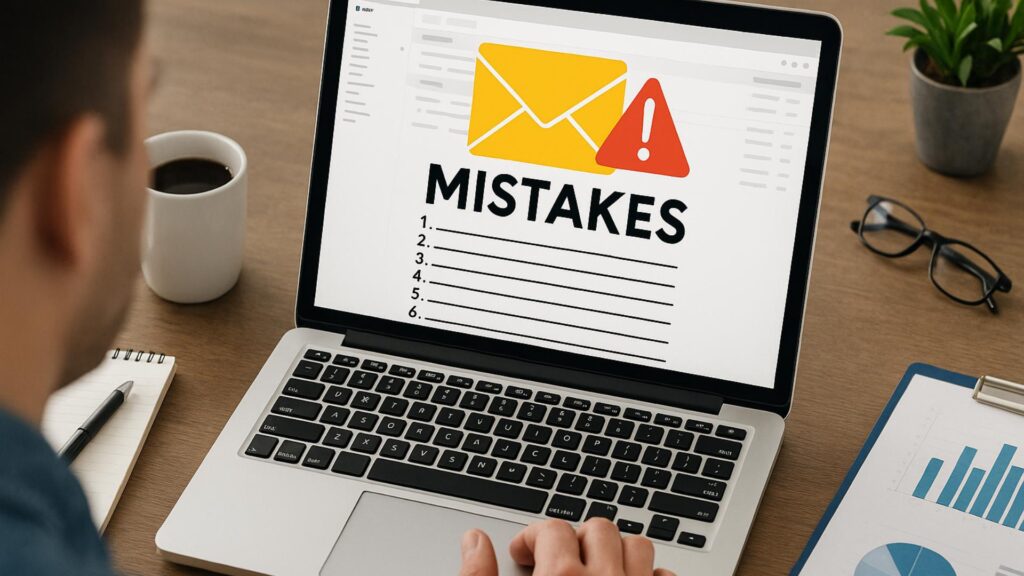In the relentless whirl of today’s digital landscape, email marketing stands as a beacon of direct, personal communication. Yet, the path to success in email campaigns is paved with potential missteps. With the right strategy, email can be the undisputed king of content marketing, but it can also become a colossal waste of resources if mishandled. Join us as we delve into the top email marketing mistakes and unveil strategies to avoid them, ensuring your emails resonate with your subscribers and drive results.
Ignoring Your Subscriber List’s Health
Let’s start with the lifeblood of any email marketing campaign—our subscriber list. A clean, healthy list is non-negotiable. However, many of us fall into the trap of sending emails to outdated or irrelevant addresses, leading to dismal open rates and potentially damaging sender reputation.
Common Pitfalls:
- Stale Data: Over time, emails bounce, addresses change, and preferences shift. Regularly purging inactive or incorrect addresses is imperative.
- Unsegmented Lists: Sending the same email to every subscriber can kill engagement. Personalization is key to catching the reader’s eye, ensuring content is relevant and timely.
- Privacy Breaches: With data security concerns at an all-time high, mishandling subscriber information can lead to severe repercussions—from trust erosion to legal action.
Strategies to Thrive:
- Conduct Regular Audits: Perform routine checks to remove duplicates, inactive addresses, and bounced emails.
- Embrace Segmentation: Group subscribers by interests, behavior, or demographics to tailor content effectively.
- Prioritize Privacy: Implement robust data protection protocols and reassure subscribers of your commitment to their privacy.
Crafting Lackluster Subject Lines
The subject line is your email’s first impression, a virtual handshake with your reader. Yet, crafting a compelling subject often gets overlooked. A hackneyed or vague subject line can spell doom for your email open rates.
Blunders to Avoid:
- Vague or Misleading Promises: Misleading readers with your subject line erodes trust and can increase spam complaints.
- Overused Clichés: Overly familiar phrases like “This is Not a Joke!” or “Last Chance!” can become white noise in a crowded inbox.
- Ignoring Mobile Optimization: With many reading emails on the go, subject lines that don’t display well on mobile devices risk being ignored.
Winning Tactics:
- A/B Testing: Regularly test different subject lines to see what resonates best with your audience.
- Keep it Crisp & Relevant: Use clear, concise language and incorporate actionable verbs to incite curiosity or urgency.
- Leverage Personalization: Use data to infuse subject lines with personal elements, making the email feel tailor-made for the recipient. {image_content}
Neglecting the Content’s Evolution
An email campaign’s content is its voice, yet too often, we find ourselves recycling tired templates or ignoring modern preferences. In the fast-paced world of digital communication, content must evolve to stay engaging.
Common Oversights:
- Overloading with Text: In an era where brevity reigns supreme, emails that resemble novels are likely to be closed before they’re read.
- Ignoring Visual Appeal: Modern readers crave multimedia. Failing to include engaging visuals, icons, or infographics can weaken your message.
- Lack of Clear Call-to-Actions (CTAs): Emails without a clear next step leave readers in limbo, unsure of what to do next.
Content Crafting Techniques:
- Streamline Content: Break text into digestible chunks, using bullet points or numbered lists.
- Integrate Visuals: Enhance engagement with relevant images, GIFs, or videos that complement your message.
- Define Your CTAs: Make CTAs prominent and direct, leading your audience seamlessly to the next step.
The Timing Trap: When to Hit Send
The timing of when we send our email can significantly impact its success. Yet, many marketers neglect to consider when their audience is most receptive, leading to missed opportunities and squandered reach.
Mistakes in Timing:
- Ignoring Time Zones: Sending emails at a time convenient for you might not align with your audience’s schedule.
- Over-Scheduling: Bombarding subscribers with excessive emails can lead to fatigue and unsubscribes.
- Not Testing Different Send Times: Failing to experiment with different times of day or week limits potential engagement insights.
Timing Tactics to Consider:
- Analyze Your Audience: Use data analytics to understand when your subscribers are most active.
- Cultivate Patience: Avoid overwhelming your list with frequent emails—prioritize quality over quantity.
- Conduct Send Time Tests: Try varying send times to see what resonates best with your audience. Adjust based on performance data.
Overlooking the Importance of Testing
Testing is the unsung hero of successful email campaigns. Yet, many of us skip this crucial step, assuming what worked once will work always. This oversight can lead to lackluster performance, unchecked errors, and missed opportunities.
Frequent Missteps:
- Assuming Performance: Thinking a successful past campaign guarantees future success ignores the dynamic nature of audience preferences.
- Neglecting Technical Tests: Failing to verify that all links work, images display, and formatting appears correctly on all devices can damage credibility.
- Disregarding Data Insights: Ignoring analytics prevents us from identifying areas of improvement or success.
Testing Techniques:
- Embrace A/B Testing: Experiment with different content elements—subject lines, visuals, or CTAs—to see what works best.
- Implement Technical Audits: Ensure emails are mobile-friendly, links are functional, and the layout is consistent across different platforms.
- Utilize Data Analytics: Continuously review performance metrics to refine your approach and make informed decisions.
Navigating the world of email marketing is akin to mastering a craft—there’s always room for improvement, refinement, and innovation. By avoiding these common missteps and embracing a strategy that prioritizes subscriber experience, personalized content, and diligent testing, we can transform our campaigns into powerhouse communications that resonate and deliver. As we continue to evolve, let’s approach each campaign as an opportunity to learn, grow, and connect with our audience in meaningful ways. After all, email isn’t just about messages—it’s about building bridges.
FAQ
What are some common mistakes in email list building?
A frequent error is purchasing email lists, which often results in low engagement and high unsubscribe rates. Instead, focus on organic growth through sign-up incentives and opt-in forms on your website.
How can I ensure my emails don’t end up in the spam folder?
Avoid using spammy language or excessive punctuation. Regularly update your list to remove inactive subscribers, and always provide a clear option to unsubscribe.
Why is personalization important in email marketing?
Personalization increases engagement by making content more relevant to the recipient. This can be achieved by segmenting your audience and using their names or past behavior to tailor the message.
What is the impact of not optimizing emails for mobile devices?
Over half of emails are opened on mobile devices. If your emails aren’t mobile-friendly, you risk losing a significant portion of your audience, as they may find it difficult to read or interact with your content.
How often should I send email campaigns to my subscribers?
There is no one-size-fits-all answer, but the key is consistency. Consider your audience’s preferences and test different frequencies to determine what results in the highest engagement without overwhelming your subscribers.



